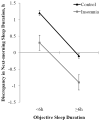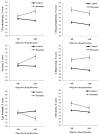Sleep misperception and chronic insomnia in the general population: role of objective sleep duration and psychological profiles
- PMID: 20978224
- PMCID: PMC3408864
- DOI: 10.1097/PSY.0b013e3181fe365a
Sleep misperception and chronic insomnia in the general population: role of objective sleep duration and psychological profiles
Abstract
Objective: To examine the role of objective sleep duration, a novel marker in phenotyping insomnia, and psychological profiles on sleep misperception in a large, general population sample. Sleep misperception is considered by some investigators a common characteristic of chronic insomnia, whereas others propose it as a separate diagnosis. The frequency and the determinants of sleep misperception in general population samples are unknown.
Methods: A total of 142 insomniacs and 724 controls selected from a general random sample of 1,741 individuals (aged ≥20 years) underwent a polysomnographic evaluation, completed the Minnesota Multiphasic Personality Inventory-2, and were split into two groups based on their objective sleep duration: "normal sleep duration" (≥6 hours) and "short sleep duration" (<6 hours).
Results: The discrepancy between subjective and objective sleep duration was determined by two independent factors. Short sleepers reported more sleep than they objectively had, and insomniacs reported less sleep than controls with similar objective sleep duration. The additive effect of these two factors resulted in underestimation only in insomniacs with normal sleep duration. Insomniacs with normal sleep duration showed a Minnesota Multiphasic Personality Inventory-2 profile of high depression and anxiety and low ego strength, whereas insomniacs with short sleep duration showed a profile of a medical disorder.
Conclusions: Underestimation of sleep duration is prevalent among insomniacs with objective normal sleep duration. Anxious-ruminative traits and poor resources for coping with stress seem to mediate the underestimation of sleep duration. These data further support the validity and clinical utility of objective sleep measures in phenotyping insomnia.
Conflict of interest statement
All authors report no biomedical financial interests or potential conflicts of interest.
Figures


References
-
- National Institutes of Health. National Institutes of Health State of the Science Conference statement on Manifestations and Management of Chronic Insomnia in Adults. Sleep. 2005;28:1049–57. - PubMed
-
- American Psychiatric Association. Diagnostic and Statistical Manual of Mental Disorders. 4. Washington: American Psychiatric Press; 2000. Text revision.
-
- Reynolds CF, 3rd, Kupfer DJ, Buysse DJ, Coble PA, Yeager A. Subtyping DSM-III-R primary insomnia: a literature review by the DSM-IV Work Group on Sleep Disorders. Am J Psychiatry. 1991;148:432–38. - PubMed
-
- Edinger JD, Krystal AD. Subtyping primary insomnia: is sleep state misperception a distinct clinical entity? Sleep Med Rev. 2003;7:203–14. - PubMed
Publication types
MeSH terms
Grants and funding
LinkOut - more resources
Full Text Sources
Medical

